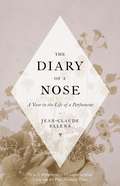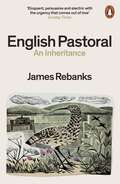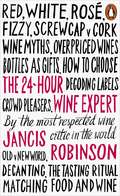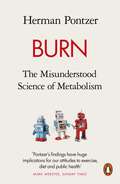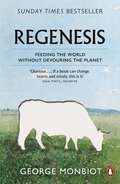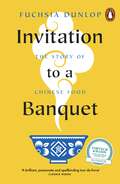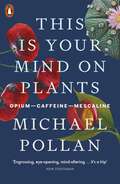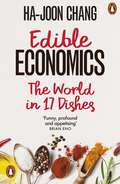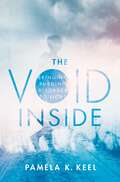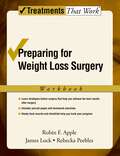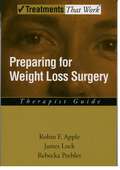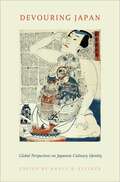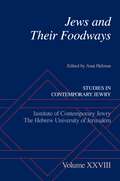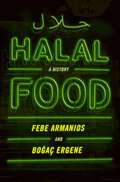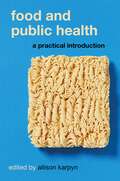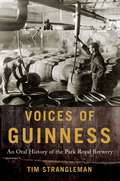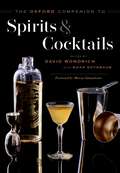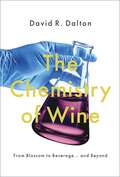- Table View
- List View
The Diary of a Nose: A Year in the Life of a Parfumeur
by Jean-Claude EllenaThe Diary of a Nose is the story behind the creation of a perfume, from the head perfumer at Hermès.Perfume creation is an exclusive and secretive endeavour. What is day to day life like for a perfume-maker? How does the creation of a new scent begin? How do you capture the essence of a smell on the skin?For one year, Jean-Claude Ellena kept a diary of his life as 'parfumeur exclusif' ('le nez' or 'the nose') for Hermès. Believing that creating a scent is like creating a work of art, and describing himself as a writer using 'olfactory colours', he explains how all of the five senses come into play when creating a perfume. He also reveals how inspiration can come from a market stall, a landscape, or even the movement of calligraphy, and concludes this charming, perceptive diary with recipes for natural fragrances, each made up of three synthetic ingredients, to create the illusion of smells like freesia, orange blossom, grapefruit, pear, chocolate, cashew and cotton candy.This is the story of a quest to capture what is most elusive. Jean-Claude Ellena offer readers a rare insight into the secrets of his business, his art, and his life as one of the world's most important and admired perfumers.
English Pastoral: An Inheritance
by James RebanksThe author of the beloved No.1 bestseller The Shepherd's Life returns with a stirring history of family, loss and the land over three generations on a Lake District farm'I can't imagine anyone starting to read English Pastoral and not being eager to read it all at once, as I did, and not being moved by the life and the landscape Rebanks describes so well. I was thrilled by it' Philip Pullman As a boy, James Rebanks's grandfather taught him to work the land the old way. Their family farm in the Lake District hills was part of an ancient agricultural landscape: a patchwork of crops and meadows, of pastures grazed with livestock, and hedgerows teeming with wildlife. And yet, by the time James inherited the farm, it was barely recognisable. The men and women had vanished from the fields; the old stone barns had crumbled; the skies had emptied of birds and their wind-blown song. English Pastoral is the story of an inheritance: one that affects us all. It tells of how rural landscapes around the world were brought close to collapse, and the age-old rhythms of work, weather, community and wild things were lost. And yet this elegy from the northern fells is also a song of hope: of how, guided by the past, one farmer began to salvage a tiny corner of England that was now his, doing his best to restore the life that had vanished and to leave a legacy for the future. This is a book about what it means to have love and pride in a place, and how, against all the odds, it may still be possible to build a new pastoral: not a utopia, but somewhere decent for us all.
The 24-Hour Wine Expert
by Jancis RobinsonWine is now one of the most popular drinks in the world. Many wine drinkers wish they knew more about it without having to understand every detail or go on a wine course. In The 24-Hour Wine Expert, Jancis Robinson shares her expertise with authority, wit and approachability. From the difference between red and white, to the shape of bottles and their labels, descriptions of taste, colour and smell, to pairing wine with food and the price-quality correlation, Robinson helps us make the most of this mysteriously delicious drink.
Burn: The Misunderstood Science of Metabolism
by Herman PontzerA myth-busting tour of the body's hidden foundations from a pioneering evolutionary biologistOver the past twenty years, evolutionary biologist Herman Pontzer has conducted ground-breaking studies across a range of settings, including pioneering fieldwork with Hadza hunter-gatherers in northern Tanzania.This book draws on his eye-opening research to show how, contrary to received wisdom, exercise does not increase our metabolism. Instead, we burn calories within a very narrow range: nearly 3,000 calories per day, no matter our activity level.By taking a closer look at what happens to the energy we consume, Pontzer explores the ways in which metabolism controls every aspect of our health - from fertility to immune function - and reveals the truth about the dynamic system that sustains us. Filled with facts and memorable anecdotes, Burn will change the way you think about food, exercise and life.
Regenesis: Feeding the World without Devouring the Planet
by George Monbiot'This book calls for nothing less than a revolution in the future of food' Kate RaworthFrom the bestselling author of Feral, a breathtaking first glimpse of a new future for food and for humanityFarming is the world's greatest cause of environmental destruction - and the one we are least prepared to talk about. We criticise urban sprawl, but farming sprawls across thirty times as much land. We have ploughed, fenced and grazed great tracts of the planet, felling forests, killing wildlife, and poisoning rivers and oceans to feed ourselves. Yet millions still go hungry.Now the food system itself is beginning to falter. But, as George Monbiot shows us in this brilliant, bracingly original new book, we can resolve the biggest of our dilemmas and feed the world without devouring the planet.Regenesis is a breathtaking vision of a new future for food and for humanity. Drawing on astonishing advances in soil ecology, Monbiot reveals how our changing understanding of the world beneath our feet could allow us to grow more food with less farming. He meets the people who are unlocking these methods, from the fruit and vegetable grower revolutionising our understanding of fertility; through breeders of perennial grains, liberating the land from ploughs and poisons; to the scientists pioneering new ways to grow protein and fat. Together, they show how the tiniest life forms could help us make peace with the planet, restore its living systems, and replace the age of extinction with an age of regenesis.
Invitation to a Banquet: The Story of Chinese Food
by Fuchsia DunlopWINNER OF THE FORTNUM AND MASON FOOD BOOK AWARDLONGLISTED FOR THE ANDRE SIMON AWARD‘A brilliant, passionate and spellbinding tour de force’ Claudia RodenThe epic tale of the world's most sophisticated gastronomic culture, told through a banquet of thirty Chinese dishesChinese was the earliest truly global cuisine. When the first Chinese labourers began to sojourn and settle abroad, restaurants appeared in their wake. Yet Chinese food has the curious distinction of being both one of the world's best-loved culinary traditions and one of the least understood. For more than a century, the overwhelming dominance of a simplified form of Cantonese cooking ensured that few foreigners experienced anything of its richness and sophistication - but today that is beginning to change.In this book, the James Beard Award-winning cook and writer Fuchsia Dunlop explores the history, philosophy and techniques of China's rich and ancient culinary culture. Each chapter examines a classic dish, from mapo tofu to Dongpo pork, knife-scraped noodles to braised pomelo pith, to reveal a singular aspect of Chinese gastronomy, whether it's the importance of the soybean, the lure of exotic ingredients or the history of Buddhist vegetarian cuisine. Meeting local food producers, chefs, gourmets and home cooks as she tastes her way across the country, Fuchsia invites readers to join her on an unforgettable journey into Chinese food as it is made, cooked, eaten and considered in its homeland.Weaving together historical scholarship, mouth-watering descriptions of food and on-the-ground research conducted over the course of three decades, Invitation to a Banquet is a lively, landmark tribute to the pleasures and mysteries of Chinese cuisine.
This Is Your Mind On Plants: Opium—Caffeine—Mescaline
by Michael Pollan'It's a trip - engrossing, eye-opening, mind altering' New StatesmanFrom the international bestselling author of How to Change Your Mind ('A sweeping and often thrilling chronicle of the history of psychedelics' Guardian), comes a ground-breaking exploration of our relationship with natural drugsOf all the many things humans rely on plants for, surely the most curious is our use of them to change consciousness: to stimulate, calm, or completely alter the qualities of our mental experience. In This Is Your Mind On Plants, Michael Pollan explores three very different drugs - opium, caffeine and mescaline - and throws the fundamental strangeness of our thinking about them into sharp relief. Exploring and participating in the cultures that have grown up around these drugs, while consuming (or in the case of caffeine, trying not to consume) them, Pollan reckons with the powerful human attraction to psychoactive plants, and the equally powerful taboos. In a unique blend of history, science, memoir and reportage, Pollan shines a fresh light on a subject that is all too often treated reductively. In doing so, he proves that there is much more to say about these plants than simply debating their regulation, for when we take them into our bodies and let them change our minds, we are engaging with nature in one of the most profound ways we can. This ground-breaking and singular book holds up a mirror to our fundamental human needs and aspirations, the operations of our minds and our entanglement with the natural world.
Edible Economics: A Hungry Economist Explains the World
by Ha-Joon ChangRADIO 4 BOOK OF THE WEEK Economic thinking - about globalisation, climate change, immigration, austerity, automation and much more - in its most digestible formFor decades, a single free market philosophy has dominated global economics. But this is bland and unhealthy - like British food in the 1980s, when bestselling author and economist Ha-Joon Chang first arrived in the UK from South Korea. Just as eating a wide range of cuisines contributes to a more interesting and balanced diet, so too is it essential we listen to a variety of economic perspectives.In Edible Economics, Chang makes challenging economic ideas more palatable by plating them alongside stories about food from around the world. He uses histories behind familiar food items - where they come from, how they are cooked and consumed, what they mean to different cultures - to explore economic theory. For Chang, chocolate is a life-long addiction, but more exciting are the insights it offers into post-industrial knowledge economies; and while okra makes Southern gumbo heart-meltingly smooth, it also speaks of capitalism's entangled relationship with freedom and unfreedom. Explaining everything from the hidden cost of care work to the misleading language of the free market as he cooks dishes like anchovy and egg toast, Gambas al Ajillo and Korean dotori mook, Ha-Joon Chang serves up an easy-to-digest feast of bold ideas.Myth-busting, witty and thought-provoking, Edible Economics shows that getting to grips with the economy is like learning a recipe: if we understand it, we can change it - and, with it, the world.
The Void Inside: Bringing Purging Disorder to Light
by Pamela K. KeelPurging disorder is characterized by vomiting or misuse of laxatives or other medications, after normal food intake, to control weight or shape. More than two million girls and women in the US suffer from purging disorder, and nearly a half million boys and men join them. But purging disorder's status as an "other" eating disorder has left it invisible to all but those who experience it firsthand. The Void Inside: Bringing Purging Disorder to Light chronicles the growing recognition of purging disorder at the turn of the millennium, reviews what science has taught us about the illness, and explains the medical complications that purging may bring. Pamela K. Keel, known for her work identifying and naming purging disorder, presents irrefutable evidence that it can no longer be considered a subset of better-known eating disorders. She also provides helpful and accessible information on assessment and treatment, and on what recovery looks like after a diagnosis of purging disorder. Drawing on the stories and words of those directly impacted by purging disorder, Keel illuminates how the illness impacts the lives of real people to underscore the severity of this hidden eating disorder, its chronicity, and the need for greater awareness. The Void Inside is an essential resource for accurate, scientifically-based information for those with purging disorder, their friends and loved ones, health professionals, educators, and anyone interested in knowing more about this severe psychiatric illness.
The Void Inside: Bringing Purging Disorder to Light
by Pamela K. KeelPurging disorder is characterized by vomiting or misuse of laxatives or other medications, after normal food intake, to control weight or shape. More than two million girls and women in the US suffer from purging disorder, and nearly a half million boys and men join them. But purging disorder's status as an "other" eating disorder has left it invisible to all but those who experience it firsthand. The Void Inside: Bringing Purging Disorder to Light chronicles the growing recognition of purging disorder at the turn of the millennium, reviews what science has taught us about the illness, and explains the medical complications that purging may bring. Pamela K. Keel, known for her work identifying and naming purging disorder, presents irrefutable evidence that it can no longer be considered a subset of better-known eating disorders. She also provides helpful and accessible information on assessment and treatment, and on what recovery looks like after a diagnosis of purging disorder. Drawing on the stories and words of those directly impacted by purging disorder, Keel illuminates how the illness impacts the lives of real people to underscore the severity of this hidden eating disorder, its chronicity, and the need for greater awareness. The Void Inside is an essential resource for accurate, scientifically-based information for those with purging disorder, their friends and loved ones, health professionals, educators, and anyone interested in knowing more about this severe psychiatric illness.
Preparing for Weight Loss Surgery (Treatments That Work)
by James Lock Robin F. Apple Rebecka PeeblesWeight loss surgery is becoming more and more popular as a long-term solution for people to regain control of their bodies and their health. Once you make the decision to undergo surgery, it is up to you to ensure the best possible outcome. This will entail radical changes in both your lifestyle and eating habits. To reap the maximum benefits of your weight loss surgery, you must learn new methods for dealing with unhealthy attitudes about food. When used in conjunction with therapy, this workbook provides practical tools that have been scientifically tested and shown to help people successfully prepare for, and overcome the post-operative challenges of creating new and healthy eating and lifestyle habits. This treatment program does more than teach you how to guarantee yourself a successful recovery after surgery; it teaches you the skills to manage your health and weight for the rest of your life. This workbook includes user-friendly devices to help you learn these new skills, including food records and checklists, body image journals, weight graphs, problem-solving exercises, and interactive homework assignments. Written by professionals in the area of eating disorders and obesity, this book will help you take control of your health as you begin your new life after weight loss surgery. TreatmentsThatWorkTM represents the gold standard of behavioral healthcare interventions! · All programs have been rigorously tested in clinical trials and are backed by years of research · A prestigious scientific advisory board, led by series Editor-In-Chief David H. Barlow, reviews and evaluates each intervention to ensure that it meets the highest standard of evidence so you can be confident that you are using the most effective treatment available to date · Our books are reliable and effective and make it easy for you to provide your clients with the best care available · Our corresponding workbooks contain psychoeducational information, forms and worksheets, and homework assignments to keep clients engaged and motivated · A companion website (www.oup.com/us/ttw) offers downloadable clinical tools and helpful resources · Continuing Education (CE) Credits are now available on select titles in collaboration with PsychoEducational Resources, Inc. (PER)
Preparing for Weight Loss Surgery (Treatments That Work)
by James Lock Robin F. Apple Rebecka PeeblesObesity has quickly become an American epidemic. People suffering from significant overweight often have to contend with a lifetime of significant comorbidities, social stigma, and lower quality of life. Recently, more and more people are undergoing weight loss surgery as a way to resolve these issues. If you are working with pre- or post-operative bariatric surgery patients, your goal is to teach them the skills they need to ensure themselves a successful surgical outcome. After surgery, patients are required to adhere to a strict diet and the very specific recommendations of their surgical "team." Without a high level of commitment from the patient to follow these recommendations, the potential for maintained weight loss after surgery is very limited. Preparing for Your Weight Loss Surgery, Therapist Guide contains a series of scientifically tested cognitive-behavioral techniques to help you prepare your patient for the post-operative challenges of creating radically changed eating and lifestyle habits. It provides instructions for teaching your patient basic problem-solving and cognitive restructuring methods that will change their negative thoughts and attitudes about food. Interactive forms including food records and checklists, body image journals, and homework assignments found in the corresponding patient workbook round out this comprehensive treatment package. TreatmentsThatWorkTM represents the gold standard of behavioral healthcare interventions! · All programs have been rigorously tested in clinical trials and are backed by years of research · A prestigious scientific advisory board, led by series Editor-In-Chief David H. Barlow, reviews and evaluates each intervention to ensure that it meets the highest standard of evidence so you can be confident that you are using the most effective treatment available to date · Our books are reliable and effective and make it easy for you to provide your clients with the best care available · Our corresponding workbooks contain psychoeducational information, forms and worksheets, and homework assignments to keep clients engaged and motivated · A companion website (www.oup.com/us/ttw) offers downloadable clinical tools and helpful resources · Continuing Education (CE) Credits are now available on select titles in collaboration with PsychoEducational Resources, Inc. (PER)
Devouring Japan: Global Perspectives on Japanese Culinary Identity
In recent years Japan's cuisine, or washoku, has been eclipsing that of France as the world's most desirable food. UNESCO recognized washoku as an intangible cultural treasure in 2013 and Tokyo boasts more Michelin-starred restaurants than Paris and New York combined. International enthusiasm for Japanese food is not limited to haute cuisine; it also encompasses comfort foods like ramen, which has reached cult status in the U.S. and many world capitals. Together with anime, pop music, fashion, and cute goods, cuisine is part of the "Cool Japan" brand that promotes the country as a new kind of cultural superpower. This collection of essays offers original insights into many different aspects of Japanese culinary history and practice, from the evolution and characteristics of particular foodstuffs to their representation in literature and film, to the role of foods in individual, regional, and national identity. It features contributions by both noted Japan specialists and experts in food history. The authors collectively pose the question "what is washoku?" What culinary values are imposed or implied by this term? Which elements of Japanese cuisine are most visible in the global gourmet landscape and why? Essays from a variety of disciplinary perspectives interrogate how foodways have come to represent aspects of a "unique" Japanese identity and are infused with official and unofficial ideologies. They reveal how Japanese culinary values and choices, past and present, reflect beliefs about gender, class, and race; how they are represented in mass media; and how they are interpreted by state and non-state actors, at home and abroad. They examine the thoughts, actions, and motives of those who produce, consume, promote, and represent Japanese foods.
DEVOURING JAPAN C: Global Perspectives on Japanese Culinary Identity
by Nancy K. StalkerIn recent years Japan's cuisine, or washoku, has been eclipsing that of France as the world's most desirable food. UNESCO recognized washoku as an intangible cultural treasure in 2013 and Tokyo boasts more Michelin-starred restaurants than Paris and New York combined. International enthusiasm for Japanese food is not limited to haute cuisine; it also encompasses comfort foods like ramen, which has reached cult status in the U.S. and many world capitals. Together with anime, pop music, fashion, and cute goods, cuisine is part of the "Cool Japan" brand that promotes the country as a new kind of cultural superpower. This collection of essays offers original insights into many different aspects of Japanese culinary history and practice, from the evolution and characteristics of particular foodstuffs to their representation in literature and film, to the role of foods in individual, regional, and national identity. It features contributions by both noted Japan specialists and experts in food history. The authors collectively pose the question "what is washoku?" What culinary values are imposed or implied by this term? Which elements of Japanese cuisine are most visible in the global gourmet landscape and why? Essays from a variety of disciplinary perspectives interrogate how foodways have come to represent aspects of a "unique" Japanese identity and are infused with official and unofficial ideologies. They reveal how Japanese culinary values and choices, past and present, reflect beliefs about gender, class, and race; how they are represented in mass media; and how they are interpreted by state and non-state actors, at home and abroad. They examine the thoughts, actions, and motives of those who produce, consume, promote, and represent Japanese foods.
Jews and Their Foodways (Studies in Contemporary Jewry)
Food is not just a physical necessity but also a composite commodity. It is part of a communication system, a nonverbal medium for expression, and a marker of special events. Bringing together contributions from fourteen historians, anthropologists, sociologists, and literary critics, Volume XXVIII of Studies in Contemporary Jewry presents various viewpoints on the subtle and intricate relations between Jews and their foodways. The ancient Jewish community ritualized and codified the sphere of food; by regulating specific and detailed culinary laws, Judaism extended and accentuated food's cultural meanings. Modern Jewry is no longer defined exclusively in religious terms, yet a decrease in the role of religion, including kashrut observance, does not necessarily entail any diminishment of the role of food. On the contrary, as shown by the essays in this volume, choices of food take on special importance when Jewish individuals and communities face the challenges of modernity. Following an introduction by Sidney Mintz and concluding with an overview by Richard Wilk, the symposium essays lead the reader from the 20th century to the 21st, across Europe, the Middle East, Africa, and North America. Through periods of war and peace, voluntary immigrations and forced deportations, want and abundance, contemporary Jews use food both for demarcating new borders in rapidly changing circumstances and for remembering a diverse heritage. Despite a tendency in traditional Jewish studies to focus on "high" culture and to marginalize "low" culture, Jews and Their Foodways demonstrates how an examination of people's eating habits helps to explain human life and its diversity through no less than the study of great events, the deeds of famous people, and the writings of distinguished rabbis.
Halal Food: A History
by Febe Armanios Bogac ErgeneFood trucks announcing "halal" proliferate in many urban areas but how many non-Muslims know what this means, other than cheap lunch? Here Middle Eastern historians Febe Armanios and Bogac Ergene provide an accessible introduction to halal (permissible) food in the Islamic tradition, exploring what halal food means to Muslims and how its legal and cultural interpretations have changed in different geographies up to the present day. Historically, Muslims used food to define their identities in relation to co-believers and non-Muslims. Food taboos are rooted in the Quran and prophetic customs, as well as writings from various periods and geographical settings. As in Judaism and among certain Christian sects, Islamic food traditions make distinctions between clean and impure, and dietary choices and food preparation reflect how believers think about broader issues. Traditionally, most halal interpretations focused on animal slaughter and the consumption of intoxicants. Muslims today, however, must also contend with an array of manufactured food products--yogurts, chocolates, cheeses, candies, and sodas--filled with unknown additives and fillers. To help consumers navigate the new halal marketplace, certifying agencies, government and non-government bodies, and global businesses vie to meet increased demands for food piety. At the same time, blogs, cookbooks, restaurants, and social media apps have proliferated, while animal rights and eco-conscious activists seek to recover halal's more wholesome and ethical inclinations. Covering practices from the Middle East and North Africa to South Asia, Europe, and North America, this timely book is for anyone curious about the history of halal food and its place in the modern world.
Jews and Their Foodways (Studies in Contemporary Jewry)
by Anat HelmanFood is not just a physical necessity but also a composite commodity. It is part of a communication system, a nonverbal medium for expression, and a marker of special events. Bringing together contributions from fourteen historians, anthropologists, sociologists, and literary critics, Volume XXVIII of Studies in Contemporary Jewry presents various viewpoints on the subtle and intricate relations between Jews and their foodways. The ancient Jewish community ritualized and codified the sphere of food; by regulating specific and detailed culinary laws, Judaism extended and accentuated food's cultural meanings. Modern Jewry is no longer defined exclusively in religious terms, yet a decrease in the role of religion, including kashrut observance, does not necessarily entail any diminishment of the role of food. On the contrary, as shown by the essays in this volume, choices of food take on special importance when Jewish individuals and communities face the challenges of modernity. Following an introduction by Sidney Mintz and concluding with an overview by Richard Wilk, the symposium essays lead the reader from the 20th century to the 21st, across Europe, the Middle East, Africa, and North America. Through periods of war and peace, voluntary immigrations and forced deportations, want and abundance, contemporary Jews use food both for demarcating new borders in rapidly changing circumstances and for remembering a diverse heritage. Despite a tendency in traditional Jewish studies to focus on "high" culture and to marginalize "low" culture, Jews and Their Foodways demonstrates how an examination of people's eating habits helps to explain human life and its diversity through no less than the study of great events, the deeds of famous people, and the writings of distinguished rabbis.
Food and Public Health: A Practical Introduction
A new introduction to public health's most elemental topic Food is baked in to most things that public health is and does. But for a field charged with carrying torches as divergent as anti-hunger and anti-obesity, it's unlikely, even impossible, to shape a unified approach to complex concepts like food environment, food access, or even nutrition. Food and Public Health offers a contextualized, accessible introduction to understanding the foundations (and contradictions) at the intersection of these two topics. It distills the historical, political, sociological, and scientific factors influencing what we eat and where our food comes from, then offers actionable insights for future nutritionists, social workers, dietitians, and researchers in public health. Guiding the reader through more than a century of food-focused regulation, policy, and education, Food and Public Health is an essential introduction to: · food production and availability on a global and neighborhood scale · dietary guidelines, agricultural subsidies, rationing, and other attempts by governments to shape their citizens' diets · best practices in health promotion and chronic disease prevention · food insecurity and its paradoxical role as driver of both hunger and obesity Enriched with real-world examples and case studies, Food and Public Health offers a crucial link between kitchen tables and populations for the classroom.
Food and Public Health: A Practical Introduction
by Allison KarpynA new introduction to public health's most elemental topic Food is baked in to most things that public health is and does. But for a field charged with carrying torches as divergent as anti-hunger and anti-obesity, it's unlikely, even impossible, to shape a unified approach to complex concepts like food environment, food access, or even nutrition. Food and Public Health offers a contextualized, accessible introduction to understanding the foundations (and contradictions) at the intersection of these two topics. It distills the historical, political, sociological, and scientific factors influencing what we eat and where our food comes from, then offers actionable insights for future nutritionists, social workers, dietitians, and researchers in public health. Guiding the reader through more than a century of food-focused regulation, policy, and education, Food and Public Health is an essential introduction to: · food production and availability on a global and neighborhood scale · dietary guidelines, agricultural subsidies, rationing, and other attempts by governments to shape their citizens' diets · best practices in health promotion and chronic disease prevention · food insecurity and its paradoxical role as driver of both hunger and obesity Enriched with real-world examples and case studies, Food and Public Health offers a crucial link between kitchen tables and populations for the classroom.
Voices of Guinness: An Oral History of the Park Royal Brewery (Oxford Oral History Series)
by Tim StranglemanImagine a workplace where workers enjoyed a well-paid job for life, one where they could start their day with a pint of stout and a smoke, and enjoy free meals in silver service canteens and restaurants. During their breaks they could explore acres of parkland planted with hundreds of trees and thousands of shrubs. Imagine after work a place where employees could play more than thirty sports, or join one of the theater groups or dozens of other clubs. Imagine a place where at the end of a working life you could enjoy a company pension from a scheme to which you had never contributed a penny. Imagine working in buildings designed by an internationally renowned architect whose brief was to create a building that "would last a century or two." This is no fantasy or utopian vision of work but a description of the working conditions enjoyed by employees at the Guinness brewery established at Park Royal in West London in the mid-1930s. In this book, Tim Strangleman tells the story of the Guinness brewery at Park Royal, showing how the history of one plant tells us a much wider story about changing attitudes and understandings about work and the organization in the twentieth and early twenty-first centuries. Drawing on extensive oral history interviews with staff and management as well as a wealth of archival and photographic sources, the book shows how progressive ideas of workplace citizenship came into conflict with the pressure to adapt to new expectations about work and its organization. Strangleman illustrates how these changes were experienced by those on the shop floor from the 1960s through to the final closure of the plant in 2005. This book asks striking and important questions about employment and the attachment workers have to their jobs, using the story of one of the UK and Ireland's most beloved brands, Guinness.
Voices of Guinness: An Oral History of the Park Royal Brewery (Oxford Oral History Series)
by Tim StranglemanImagine a workplace where workers enjoyed a well-paid job for life, one where they could start their day with a pint of stout and a smoke, and enjoy free meals in silver service canteens and restaurants. During their breaks they could explore acres of parkland planted with hundreds of trees and thousands of shrubs. Imagine after work a place where employees could play more than thirty sports, or join one of the theater groups or dozens of other clubs. Imagine a place where at the end of a working life you could enjoy a company pension from a scheme to which you had never contributed a penny. Imagine working in buildings designed by an internationally renowned architect whose brief was to create a building that "would last a century or two." This is no fantasy or utopian vision of work but a description of the working conditions enjoyed by employees at the Guinness brewery established at Park Royal in West London in the mid-1930s. In this book, Tim Strangleman tells the story of the Guinness brewery at Park Royal, showing how the history of one plant tells us a much wider story about changing attitudes and understandings about work and the organization in the twentieth and early twenty-first centuries. Drawing on extensive oral history interviews with staff and management as well as a wealth of archival and photographic sources, the book shows how progressive ideas of workplace citizenship came into conflict with the pressure to adapt to new expectations about work and its organization. Strangleman illustrates how these changes were experienced by those on the shop floor from the 1960s through to the final closure of the plant in 2005. This book asks striking and important questions about employment and the attachment workers have to their jobs, using the story of one of the UK and Ireland's most beloved brands, Guinness.
The Oxford Companion to Spirits and Cocktails
by Noah RothbaumAnthropologists and historians have confirmed the central role alcohol has played in nearly every society since the dawn of human civilization, but it is only recently that it has been the subject of serious scholarly inquiry. The Oxford Companion to Spirits and Cocktails is the first major reference work to cover the subject from a global perspective, and provides an authoritative, enlightening, and entertaining overview of this third branch of the alcohol family. It will stand alongside the bestselling Companions to Wine and Beer, presenting an in-depth exploration of the world of spirits and cocktails in a groundbreaking synthesis. The Companion covers drinks, processes, and techniques from around the world as well as those in the US and Europe. It provides clear explanations of the different ways that spirits are produced, including fermentation, distillation, and ageing, alongside a wealth of new detail on the emergence of cocktails and cocktail bars, including entries on key cocktails and influential mixologists and cocktail bars. With entries ranging from Manhattan and mixology to sloe gin and stills, the Companion combines coverage of the range of spirit-based drinks around the world with clear explanations of production processes, and the history and culture of their consumption. It is the ultimate guide to understanding what is in your glass. The Companion is lavishly illustrated throughout, and appendices include a timeline of spirits and distillation and a guide to mixing drinks.
The Oxford Companion to Spirits and Cocktails
by Noah RothbaumAnthropologists and historians have confirmed the central role alcohol has played in nearly every society since the dawn of human civilization, but it is only recently that it has been the subject of serious scholarly inquiry. The Oxford Companion to Spirits and Cocktails is the first major reference work to cover the subject from a global perspective, and provides an authoritative, enlightening, and entertaining overview of this third branch of the alcohol family. It will stand alongside the bestselling Companions to Wine and Beer, presenting an in-depth exploration of the world of spirits and cocktails in a groundbreaking synthesis. The Companion covers drinks, processes, and techniques from around the world as well as those in the US and Europe. It provides clear explanations of the different ways that spirits are produced, including fermentation, distillation, and ageing, alongside a wealth of new detail on the emergence of cocktails and cocktail bars, including entries on key cocktails and influential mixologists and cocktail bars. With entries ranging from Manhattan and mixology to sloe gin and stills, the Companion combines coverage of the range of spirit-based drinks around the world with clear explanations of production processes, and the history and culture of their consumption. It is the ultimate guide to understanding what is in your glass. The Companion is lavishly illustrated throughout, and appendices include a timeline of spirits and distillation and a guide to mixing drinks.
The Chemistry of Wine: From Blossom to Beverage and Beyond
by David R. DaltonPoets extol the burst of aroma when the bottle is opened, the wine poured, the flavor on the palate as it combines with the olfactory expression detected and the resulting glow realized. But what is the chemistry behind it? What are the compounds involved and how do they work their wonder? What do we know? Distinct and measurable differences in terroir, coupled with the plasticity of the grape berry genome and the metabolic products, as well as the work of the vintner, are critical to the production of the symphony of flavors found in the final bottled product. Analytical chemistry can inform us about the chemical differences and similarities in the grape berry constituents with which we start and what is happening to those and other constituents as the grape matures. The details of the grape and its treatment produce substantive detectable differences in each wine. While there are clear generalities - all wine is mostly water, ethanol is usually between 10% - 20% of the volume, etc - it is the details, shown to us by Analytical Chemistry and structural analysis accompanying it, that clearly allow one wine to be distinguished from another.
The Chemistry of Wine: From Blossom to Beverage and Beyond
by David R. DaltonPoets extol the burst of aroma when the bottle is opened, the wine poured, the flavor on the palate as it combines with the olfactory expression detected and the resulting glow realized. But what is the chemistry behind it? What are the compounds involved and how do they work their wonder? What do we know? Distinct and measurable differences in terroir, coupled with the plasticity of the grape berry genome and the metabolic products, as well as the work of the vintner, are critical to the production of the symphony of flavors found in the final bottled product. Analytical chemistry can inform us about the chemical differences and similarities in the grape berry constituents with which we start and what is happening to those and other constituents as the grape matures. The details of the grape and its treatment produce substantive detectable differences in each wine. While there are clear generalities - all wine is mostly water, ethanol is usually between 10% - 20% of the volume, etc - it is the details, shown to us by Analytical Chemistry and structural analysis accompanying it, that clearly allow one wine to be distinguished from another.
